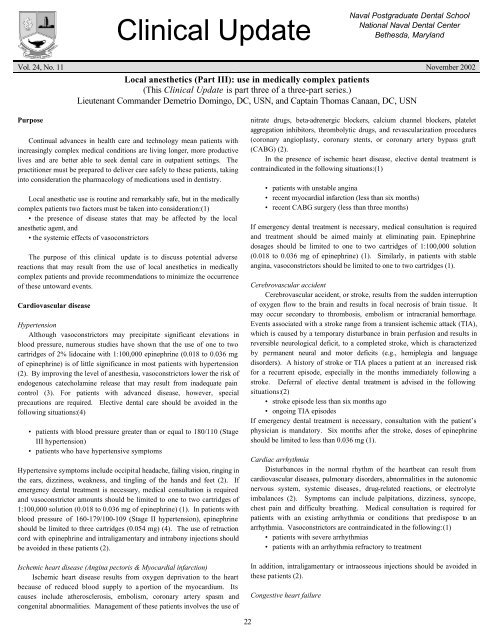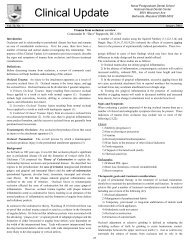Local anesthetics Part III
Local anesthetics Part III
Local anesthetics Part III
You also want an ePaper? Increase the reach of your titles
YUMPU automatically turns print PDFs into web optimized ePapers that Google loves.
Clinical UpdateNaval Postgraduate Dental SchoolNational Naval Dental CenterBethesda, MarylandVol. 24, No. 11 November 2002<strong>Local</strong> <strong>anesthetics</strong> (<strong>Part</strong> <strong>III</strong>): use in medically complex patients(This Clinical Update is part three of a three-part series.)Lieutenant Commander Demetrio Domingo, DC, USN, and Captain Thomas Canaan, DC, USNPurposeContinual advances in health care and technology mean patients withincreasingly complex medical conditions are living longer, more productivelives and are better able to seek dental care in outpatient settings. Thepractitioner must be prepared to deliver care safely to these patients, takinginto consideration the pharmacology of medications used in dentistry.<strong>Local</strong> anesthetic use is routine and remarkably safe, but in the medicallycomplex patients two factors must be taken into consideration:(1)• the presence of disease states that may be affected by the localanesthetic agent, and• the systemic effects of vasoconstrictorsThe purpose of this clinical update is to discuss potential adversereactions that may result from the use of local <strong>anesthetics</strong> in medicallycomplex patients and provide recommendations to minimize the occurrenceof these untoward events.Cardiovascular diseaseHypertensionAlthough vasoconstrictors may precipitate significant elevations inblood pressure, numerous studies have shown that the use of one to twocartridges of 2% lidocaine with 1:100,000 epinephrine (0.018 to 0.036 mgof epinephrine) is of little significance in most patients with hypertension(2). By improving the level of anesthesia, vasoconstrictors lower the risk ofendogenous catecholamine release that may result from inadequate paincontrol (3). For patients with advanced disease, however, specialprecautions are required. Elective dental care should be avoided in thefollowing situations:(4)• patients with blood pressure greater than or equal to 180/110 (Stage<strong>III</strong> hypertension)• patients who have hypertensive symptomsHypertensive symptoms include occipital headache, failing vision, ringing inthe ears, dizziness, weakness, and tingling of the hands and feet (2). Ifemergency dental treatment is necessary, medical consultation is requiredand vasoconstrictor amounts should be limited to one to two cartridges of1:100,000 solution (0.018 to 0.036 mg of epinephrine) (1). In patients withblood pressure of 160-179/100-109 (Stage II hypertension), epinephrineshould be limited to three cartridges (0.054 mg) (4). The use of retractioncord with epinephrine and intraligamentary and intrabony injections shouldbe avoided in these patients (2).Ischemic heart disease (Angina pectoris & Myocardial infarction)Ischemic heart disease results from oxygen deprivation to the heartbecause of reduced blood supply to a portion of the myocardium. Itscauses include atherosclerosis, embolism, coronary artery spasm andcongenital abnormalities. Management of these patients involves the use ofnitrate drugs, beta-adrenergic blockers, calcium channel blockers, plateletaggregation inhibitors, thrombolytic drugs, and revascularization procedures(coronary angioplasty, coronary stents, or coronary artery bypass graft(CABG) (2).In the presence of ischemic heart disease, elective dental treatment iscontraindicated in the following situations:(1)• patients with unstable angina• recent myocardial infarction (less than six months)• recent CABG surgery (less than three months)If emergency dental treatment is necessary, medical consultation is requiredand treatment should be aimed mainly at eliminating pain. Epinephrinedosages should be limited to one to two cartridges of 1:100,000 solution(0.018 to 0.036 mg of epinephrine) (1). Similarly, in patients with stableangina, vasoconstrictors should be limited to one to two cartridges (1).Cerebrovascular accidentCerebrovascular accident, or stroke, results from the sudden interruptionof oxygen flow to the brain and results in focal necrosis of brain tissue. Itmay occur secondary to thrombosis, embolism or intracranial hemorrhage.Events associated with a stroke range from a transient ischemic attack (TIA),which is caused by a temporary disturbance in brain perfusion and results inreversible neurological deficit, to a completed stroke, which is characterizedby permanent neural and motor deficits (e.g., hemiplegia and languagedisorders). A history of stroke or TIA places a patient at an increased riskfor a recurrent episode, especially in the months immediately following astroke. Deferral of elective dental treatment is advised in the followingsituations:(2)• stroke episode less than six months ago• ongoing TIA episodesIf emergency dental treatment is necessary, consultation with the patient’sphysician is mandatory. Six months after the stroke, doses of epinephrineshould be limited to less than 0.036 mg (1).Cardiac arrhythmiaDisturbances in the normal rhythm of the heartbeat can result fromcardiovascular diseases, pulmonary disorders, abnormalities in the autonomicnervous system, systemic diseases, drug-related reactions, or electrolyteimbalances (2). Symptoms can include palpitations, dizziness, syncope,chest pain and difficulty breathing. Medical consultation is required forpatients with an existing arrhythmia or conditions that predispose to anarrhythmia. Vasoconstrictors are contraindicated in the following:(1)• patients with severe arrhythmias• patients with an arrhythmia refractory to treatmentIn addition, intraligamentary or intraosseous injections should be avoided inthese patients (2).Congestive heart failure22
Congestive heart failure (CHF) is the result of the heart’s inability tofunction effectively as a pump. It is the end-stage manifestation ofnumerous cardiovascular diseases: systemic and pulmonary hypertension,coronary, valvular and congenital heart diseases, cardiomyopathy, infectiveendocarditis, and endocrine disorders (2). Signs and symptoms includerapid, shallow breathing followed by periods of apnea (Cheyne-Stokesrespirations), heart murmur, arrhythmia, jaundice, fever, cough, distendedneck veins, edema, ascites, cyanosis, weight gain, and clubbing of fingers(2). Elective dental treatment is contraindicated in patients withuncontrolled or untreated CHF, characterized by a marked limitation inphysical activities and by the presence of symptoms while at rest (1,2).Routine dental treatment is acceptable for patients with well-controlledCHF, although vasoconstrictor dosages should be limited to amountscontained in two cartridges of anesthetic (0.036 mg of epinephrine) (1).Some medications prescribed for the management of CHF havepotential interactions with vasoconstrictors. Digoxin, prescribed to increasethe heart’s contractile force, has a narrow therapeutic index and mayprecipitate a cardiac arrhythmia when used concurrently withvasoconstrictors. In patients taking nitroglycerin and other vasodilators,the diminished effects of vasoconstrictors can shorten the anesthetic’sduration of action (2). Medical consultation and monitoring of vital signsare necessary in the dental treatment of these patients.Pulmonary diseaseAsthmaAsthma results from the airway’s increased reactivity to variousstimuli. Sodium metabisulfite, used as a preservative in <strong>anesthetics</strong> withvasoconstrictors, is a known allergen that can precipitate an asthma attack.However, studies have shown that allergic reactions to sulfite-containing<strong>anesthetics</strong> are uncommon among sulfite-sensitive patients. It is estimatedthat less than four percent of asthmatics are sensitive to sulfites, and thatthese patients generally have more severe, persistent asthma and requirecorticosteroid management (1).<strong>Local</strong> <strong>anesthetics</strong> with vasoconstrictors can be used safely in patientswith mild asthma. Because of the potential risk of a hypersensitivityreaction to sulfites, however, local <strong>anesthetics</strong> with vasoconstrictors shouldbe avoided in patients with severe, persistent, corticosteroid-dependentasthma (1).should be extended. Similarly, routine use of local <strong>anesthetics</strong> is acceptable inpatients with mild hepatic disease, but dosages should be reduced andinjection intervals increased in patients with more advanced hepatic disease(e.g., cirrhosis) (1). Medical consultation is recommended prior to the dentaltreatment of these patients.Diabetes mellitusThe action of vasoconstrictors directly opposes that of insulin.Epinephrine increases gluconeogenesis and glycogen breakdown in the liver,leading to hyperglycemia. An increased hyperglycemic response toepinephrine has been observed in insulin-dependent diabetics. This riskvaries, but the diabetic’s level of blood glucose control is an importantdetermining factor. As a result, well-controlled diabetics better toleratevasoconstrictors and have fewer episodes of hyperglycemia than poorlycontrolled diabetics. Studies have shown that the amounts of epinephrinecontained in one to three cartridges of local anesthetic (0.018 to 0.054 mg)may be enough to significantly increase the risk of a complications(ketoacidosis, hyperglycemia) in patients with unstable diabetes, and soshould be avoided until their condition is brought under glycemic control (6).Patients with well-controlled diabetes, on the other hand, can generallyreceive vasoconstrictor-containing <strong>anesthetics</strong> without special precautions.Thyroid diseaseHyperthyroidismHyperthyroidism is characterized by an increased metabolic rate and thisis reflected in a constellation of symptoms that commonly include weightloss, exophthalmos and goiter. Hyperthyroid patients frequently havehypertension, cardiac arrhythmias, palpitations, and chest pain.Thytoxicosis (delirium, coma, hyperthermia, severe arrhythmia andhypotension) is a life-threatening condition and represents the most severecomplication (6,7). The well-managed or euthyroid patient is at low risk forthe hemodynamic effects of exogenous epinephrine and so normalconcentrations of vasoconstrictors may be administered (1). Untreatedhyperthyroid patients must be approached by the dentist with extremecaution. Although the existing data remain equivocal, it is recommended thatthe use of vasoconstrictors in local <strong>anesthetics</strong> be avoided in untreated orpoorly-controlled hyperthyroid patients (1,6).Chronic obstructive pulmonary diseaseThe two most common diseases classified as chronic obstructivepulmonary disease (COPD) are chronic bronchitis and emphysema. Theetiologies of these disorders are different, although both result in chronicirreversible obstruction of airflow from the lungs (2).These patients have a decreased respiratory capacity, and specialprecautions are required to prevent aggravation of symptoms. There are nocontraindications to the use of local <strong>anesthetics</strong> with vasoconstrictors,however these patients often have co-existing cardiovascular diseases whichmay require dosage modification (1). Mandibular and palatal anestheticblocks, as well placement of the rubber dam, may create a sensation ofairway constriction and should be avoided as much as possible in thesepatients (2).Renal disease and hepatic diseaseLidocaine and other amide <strong>anesthetics</strong> undergo metabolism in the liverand are excreted by the kidneys (5). The presence of renal disease can leadto inadequate clearance of local <strong>anesthetics</strong>. Although the routine use oflocal <strong>anesthetics</strong> is not contraindicated in patients with renal disease, thedosages must be kept to a minimum and the interval between injections23HypothyroidismThe decrease in metabolic rate secondary to insufficient thyroid hormoneproduction may result in an exaggerated response to the depressant effects oflocal <strong>anesthetics</strong>. Additionally, in the poorly-controlled hypothyroid patient,the stress of a dental procedure may result in myxedema coma (hypothermia,bradycardia, severe hypotension and seizures). Patients with mild symptomsof hypothyroidism are at low risk for untoward reactions when receivingdental treatment. Dosages of local <strong>anesthetics</strong>, however, should be kept to aminimum. In patients with severe or untreated hypothyroidism, electivedental treatment should be deferred until their condition is medicallycontrolled (1).References:1. Budenz AW. <strong>Local</strong> <strong>anesthetics</strong> and medically complex patients. J CalifDent Assoc 2000 Aug;28(8):611-9.2. Little JW, Fallace DA, Miller CS, Rhodus NL. Dental management of themedically compromised patient. 6 th ed. St. Louis:Mosby;2002.3. Niwa H, Sugimura M, Satoh Y, Tanimoto A. Cardiovascular response toepinephrine-containing local anesthesia in patients with cardiovascular
disease. Oral Surg Oral Med Oral Pathol Oral Radiol Endod 2001Dec;92(6):610-6.4. Glick M. New guidelines for prevention, detection, evaluation andtreatment of high blood pressure. J Am Dent Assoc 1998Nov;129(11):1588-94.5. Isen D, Hawkins JM. The pharmacology of local <strong>anesthetics</strong>. Ont Dent1995 Jul-Aug;72(6):18-22.6. Perusse R, Goulet JP, Turcotte JY. Contraindications to vasoconstrictorsin dentistry: <strong>Part</strong> II Hyperthyroidism, diabetes, sulfite sensitivity, corticodependentasthma, and pheochromocytoma. Oral Surg Oral Med OralPathol 1992 Nov;74(5):687-91.7. Sherman RG, Lasseter DH. Pharmacologic management of patients withdiseases of the endocrine system. Dent Clin North Am 1996 Jul;40(3):727-52.Dr. Domingo is a resident in the Oral Medicine Department. Dr. Canaan is afaculty member and Chairman, Oral Medicine Department, Naval PostgraduateDental School.The opinions and assertions contained in this article are the private ones ofthe authors and are not to be construed as official or reflecting the views ofthe Department of the Navy.Note: The mention of any brand names in this Clinical Update does notimply recommendation or endorsement by the Department of the Navy,Department of Defense, or the U.S. Government.24




